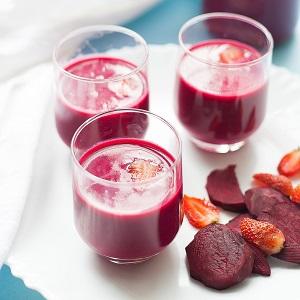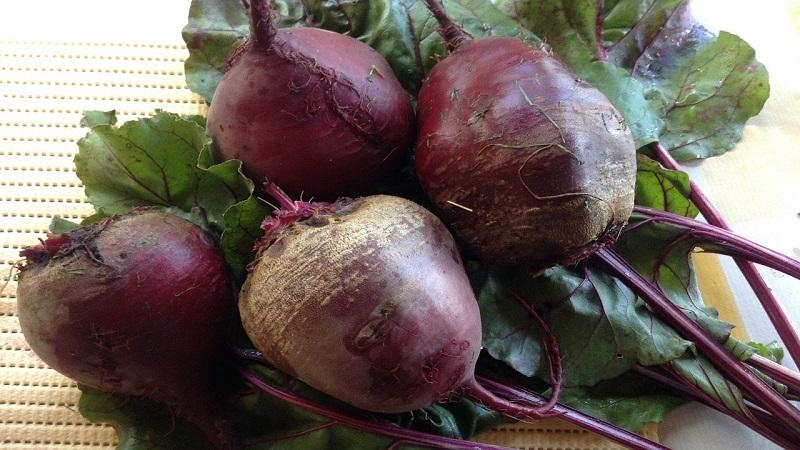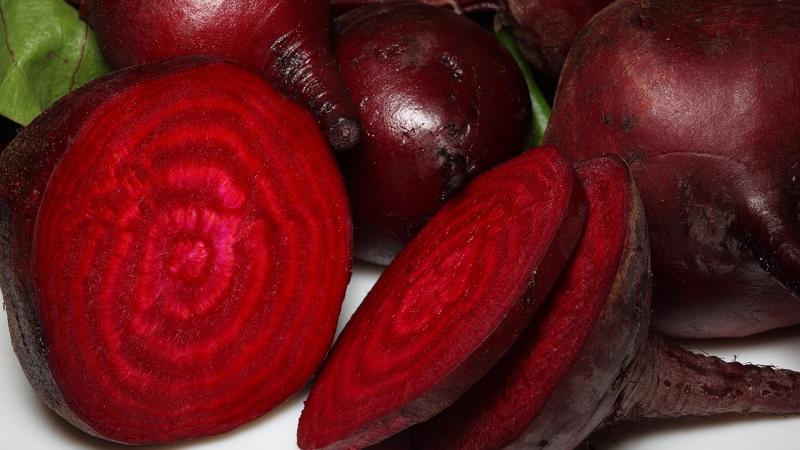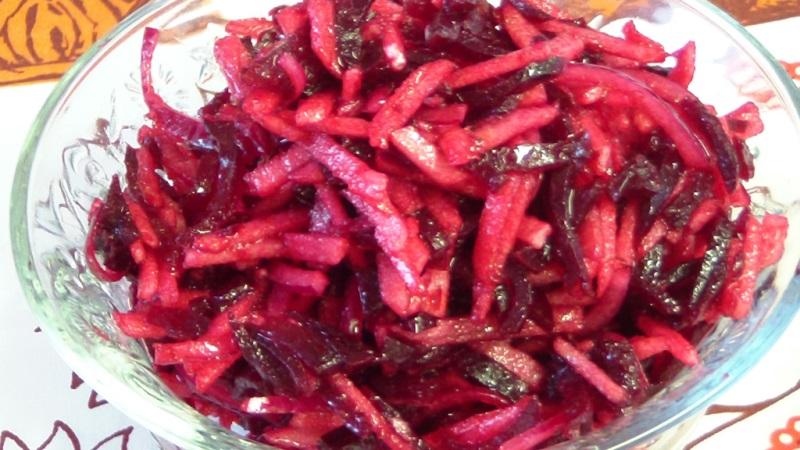How to properly use beets for pancreatitis
Diseases of the digestive system are widespread, which is associated with an increase in toxic, medicinal and viral effects. Among the frequently diagnosed diseases, pancreatitis is not the last. This is an inflammation of the tissues of the pancreas, which manifests itself in unbearable pain in the lower abdomen. In the acute period, patients are shown a gentle diet, in which, according to some gastroenterologists, one of the main food products is common beet.
Is it possible to eat beets with pancreatic pancreatitis or not, in what form the vegetable will be useful, and when it can be harmful to health, which beet dishes are the most useful and tasty - we will consider further.
The content of the article
Useful properties of a vegetable and its effect on the human body
 Beets are known for their medicinal properties and beneficial effects on pathological processes. Its huge advantage is a high and varied content of useful components, the amount of which remains practically unchanged even after heat treatment.
Beets are known for their medicinal properties and beneficial effects on pathological processes. Its huge advantage is a high and varied content of useful components, the amount of which remains practically unchanged even after heat treatment.
It is a source of betanin (improves blood formation), curcumin (has an analgesic effect), fiber (normalizes metabolic processes).
In addition, the composition contains vitamins A, B, C, PP, micro- and macroelements, such as calcium, potassium, zinc, manganese, iodine, phosphorus, copper, iron, sodium.
Beets are healthy in any form, but for diseases of the digestive system, gastroenterologists recommend using it in boiled or baked.
What are the benefits of beets:
- it burns fat, suppresses appetite, activates metabolic processes, promotes normalization of weight;
- improves blood formation, accelerates the general lymph flow, prevents the development of cardiovascular pathologies;
- reduces painful sensations, has a beneficial effect on the condition of muscle tissue;
- lowers high blood pressure;
- useful for women in the menstrual period, as it helps to cope with the symptoms of anemia: weakness, dizziness, increased irritability, apathy;
- strengthens and supports the human immune system;
- cleanses the body: removes toxins and salt deposits;
- replenishes the deficiency of vitamin A, B, C, micro- and macronutrients;
- promotes the healing of the ulcer;
- has diuretic properties: retains fluid in the renal tubules and increases the volume of urine;
- stimulates the physiological act of intestinal peristalsis (laxative effect);
- facilitates the absorption of nutrients, helps digestion, improves the functioning of the organs of the gastrointestinal tract.
To achieve a positive effect, it is necessary to consume the vegetable systematically. In addition, regular use of root vegetables in the diet improves the general condition of people with thyroid problems, chronic constipation, atherosclerosis.
Beets are also useful during pregnancy, especially in the first three months, since they contain folic acid in large doses.
Reference! The calorie content of the raw product is 43 kcal per 100 g. Due to the content of a wide range of vitamins and other substances necessary for the body, you can lose weight with beets without harming your health.

Is it possible to eat raw beets and drink beet juice
To stimulate the mechanisms of self-healing of the pancreas and alleviate the severity of symptoms, along with conservative therapy, patients are shown a special diet. Raw beets and beet juice fall into the prohibited food category.
For a healthy person, raw beets will only benefit, but in people with pancreatitis, it can provoke an exacerbation of the disease, worsen overall health. The coarse fiber of the vegetable, which is also high in fiber, is difficult to break down and absorb.
But gastroenterologists even recommend including boiled or baked beets in the diet. We repeat once again that the vegetable after heat treatment does not lose its taste characteristics and retains almost all the useful components and medicinal properties.
When can you eat beets with pancreatitis
It is impractical to include beets in the diet in the acute period. At this stage, the patient is shown fasting, and any food can harm the body, provoke a new attack of pain. Boiled red beets are allowed in chronic pancreatitis at the moment when the disease goes into remission.
Consume the vegetable after proper heat treatment, starting with one teaspoon, gradually increasing the portion to 100 g per day over several days.
Drinking beet juice in the acute period is also prohibited, despite the fact that there are no coarse fibers in its composition. The high content of acids and sugar has an adverse effect on the tissues of the pancreas, can provoke diarrhea, diarrhea, and lower blood pressure. Taking beetroot juice in the chronic course of the disease begins in a period of stable remission.
In addition, it is recommended to use it not in its pure form, but to dilute it with other vegetable juice (cabbage, carrot, potato). The drink should be infused for at least an hour, it should be taken every two to three days. The daily rate should not exceed 100 ml.
Important! If an adverse reaction such as nausea, vomiting, loose stools occurs, beetroot juice should be excluded from the diet, as it may be a sign allergies.

Recipes for the healthiest dishes with this product
Beets are used as an independent product or used as part of various dishes... It is boiled, steamed, baked. The finished product is crushed using a blender, graters, grind through a sieve - the main thing is that the output is a mushy consistency.
Consider the most popular dishes with it that are allowed during a period of persistent remission.
Boiled beetroot salad
To prepare the dish, you will need 1-2 medium-sized vegetables. We transfer the clean beet to a saucepan with cold water and cook until tender. If these are large fruits, then we first cut them into identical pieces so that the beets cook faster. The average cooking time is 1.5-2 hours.
We check the readiness with a fork. Next, peel the cooled vegetable and grind it on a grater, fill with vegetable oil, mix. To improve the taste, you can add a little boiled carrots or apples without a peel, also chopped into a fine grater.
Boiled beets for pancreatitis
Beets are prepared as in the previous recipe. It is better to grind a cooled vegetable with a blender or a meat grinder, since even finely chopped beets creates an additional burden on the digestive system and increases the risk of an exacerbation of the disease.
Optionally, you can season with olive oil, low-fat sour cream, sprinkle with low-fat grated cheese or egg white.
Council. If a root vegetable is prepared for a patient with pancreatitis, it is forbidden to add vinegar, citric acid, sour kvass or lemon juice to the water where beets are boiled. These foods help to maintain the intense color of the vegetable, but can cause a new attack of the disease.
Beetroot baked in oil
For the recipe, we take medium-sized root vegetables of the correct shape, rich dark color.Before starting cooking, turn on the oven 180-200 degrees so that it has time to warm up well.
At this time, we prepare the vegetable:
- We remove the dirt under running water, cut off the tops and roots.
- Without peeling the peel, cut into two halves.
- Cover the baking dish (it is better to choose with sides) with foil, put the beets on top with the cut down - so that half with the peel is at the top. Sprinkle liberally with olive oil.
- Cover the top with foil and put in the oven for 30-40 minutes. The cooking time is different, depending on the variety and size of the root crop. As soon as the vegetable is tender, remove from the oven.
Use the finished beets as a side dish and prepare a salad with it, and if you pour a little honey, you get a healthy and tasty dessert.
Council. Along with the beets, other vegetables can be baked in the same way: carrots, potatoes.

Beetroot
With pancreatitis, beetroot is cooked in water or light meat broth, while the meat itself is not consumed.
Based on a three-liter pan, you will need:
- 2-3 medium-sized beets;
- 4 ripe tomatoes of medium size (if small, then 5-6);
- 2 carrots;
- 2 onions;
- Bay leaf;
- greens: parsley, dill;
- beans in its own juice (optional).
For a more nutritious and tasty beetroot, cook in secondary meat broth. Better if it's chicken breast or thigh. Wash chicken, fill with water, put on low heat, bring to a boil, drain.
We wash the meat again under running water, pour purified water into a saucepan, underfilling by two or three fingers, cook over low heat, periodically removing the resulting foam.
For reference. To add flavor to the dish, after boiling, add the peeled onion, cut crosswise. It is better not to use salt and spices for taste.
While the broth is cooking, prepare the vegetables. Three peeled carrots on a grater, cut the onion into small cubes. In a hot frying pan, 1 tsp. vegetable oil over medium heat, fry the onion until transparent, add the carrots, and fry for another 2-3 minutes.
Chop a beet of your choice into thin strips, grind on a grater or using a blender. When the broth is cooked, add all the vegetables at the same time, cook until tender. At the end of cooking, remove the whole onion from the soup, sprinkle with herbs. We fill a portion of 1 tbsp. low-fat sour cream.
There is a simplified beetroot recipe, no less delicious. Pour finely chopped potatoes and onions into boiling water, chopped beets and carrots, cook until cooked for 30-40 minutes. Season with herbs. Optionally add 1 tbsp to the serving. l. sour cream with a low percentage of fat.

Conclusion
Beets for diseases of the gastrointestinal tract are not only allowed, but also necessary. It normalizes metabolic processes, removes toxins and toxins, strengthens the immune system, has a slight diuretic and laxative effect.
However, in order not to harm the body and not to aggravate the course of the disease, it is recommended to use beets for pancreatic pancreatitis after heat treatment. If you show your imagination, then unleavened boiled or baked beets can be easily turned into a delicious salad, side dish or even dessert. Bon appetit and be healthy!